
Calligraphy is the practice of writing and penmanship as a visual art form. Where the purpose of handwriting is to be as quickly written and legible as possible, calligraphy instead emphasizes expression, beauty and skill.
The term Calligraphy for most, brings to mind the classical cursive Latin script, but in actual fact is but an umbrella term that refers to many styles of writing from cultures all over the world, with each writing system giving rise to unique forms of calligraphy.
While calligraphy is practiced in some form for any language or region with a writing system, in modern times, the most well known calligraphy traditions that are upheld to this day are ‘Chinese Calligraphy’, ‘Japanese Calligraphy’, and of course ‘Western Calligraphy’.
China
Chinese calligraphy, known natively as shūf, has a deep history predating 1200 B.C, with inscriptions being found on bone carvings and bronze molds. However, calligraphy didn’t properly mature in China until around 220 B.C, with the invention of paper becoming readily available. As most of the population was functionally illiterate, calligraphy was exclusively a luxury for the elite scholars of ancient Chinese society.
Calligraphy was held in such high regard in Imperial China, that it was considered to be one of the Four Arts, also called siyi, which also consisted of playing the traditional string instrument guqin, playing the board game Go and painting. As Chinese culture had massive influence over the rest of East Asia, Chinese Calligraphy also was adopted and influenced writing systems and calligraphy in countries like Japan, Korea and Vietnam.
Today, the role calligraphy plays in China has radically changed, with much less exclusive practice. The most important principles of modern Chinese calligraphy is to be as beautiful, clear, correct and concise as possible.
Japan
For most of its history, Japanese calligraphy, also known as shodō, was directly influenced by Chinese calligraphy. Since as far back as the 13th Century BC, Japan based great amounts of its culture off China, thanks to the knowledge brought over by migrating monks.
Due to this, for the longest time, Japan only had the Chinese writing system and calligraphy was inextricably linked to religion. This would soon change, as the Japanese developed their own writing system, ‘Hiragana’.
Though calligraphy still primarily consists of Kanji characters, and was visually indistinct from Chinese calligraphy, Japan would invent unique ‘Hiragana’ based calligraphy styles that set itself apart.
Besides that, one of the more distinctive developments of Japanese calligraphy is still considering unreadable script as calligraphy, something China never adopted despite having the world’s first instances of it.
In modern Japan, calligraphy is a vital part of its culture, with it being taught in schools. Calligraphy is a popular highschool club activity and some of Japan’s top universities also offer calligraphy study programs.
With nearly 70% of the world employing the Latin alphabet, it's no surprise that Western calligraphy is easily the most widely known style. Despite the long history of the alphabet, common use was limited to religious contexts, as most of the population, much like the East, was illiterate.
It wasn’t until the 15th Century with the invention of the printing press, that certain scripts, specifically the Italic, Gothic and Roman style writing became popular. However, while the printing press and the commercial availability of paper gave rise to literacy, the aesthetic development of calligraphy in western culture declined, as the printing press made the written word redundant.
It wasn’t until the 19th century, thanks to craftsman Edward Johnston and his research and propagation of the art of calligraphy is cited as influencing the modern revival of calligraphy, inspiring any of history’s greatest modern Western Calligraphers such as Eric Gill and Graily Hewitt.
The role of calligraphy in the West is very different to the East, in that it's appreciated for its more practical and aesthetic applications, such as graphic design, documentation, and other various inscriptions.
Even with the digital age seeing most people never writing anything by hand anymore, Calligraphers have adapted with the times and used the internet to further propagate and popularise their own work as well as the deep history of Western calligraphy.

